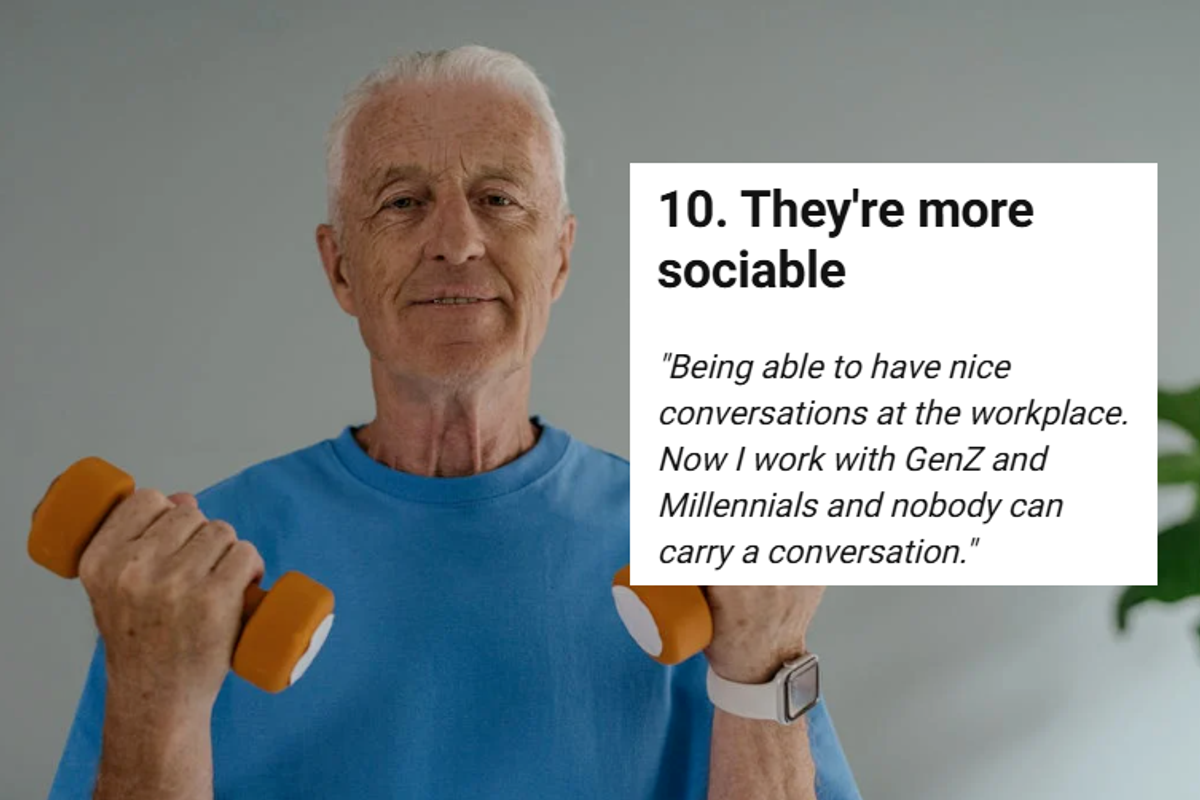Gen Xers are admitting the 17 things that baby boomers got right
Got to give credit where credit is due.

A baby boomer lifting weights.
It’s a tale as old as humanity itself; as the older generations age, the younger ones will criticize them for the world they left them. These days, baby boomers (1946 to 1964) are taking the most heat from the generations who came after, Gen X (1965 to 1980), millennials (1981 to 1996), and Gen Z (1997 to 2012). A big reason boomers take a lot of heat is that some believe they changed their values from the hippie days of the late ‘60s and early ‘70s to become the self-absorbed “Me” generation.
Baby boomers are also often criticized for hoarding wealth while younger generations struggled and for being in power during years of environmental neglect. Boomers are also known for having a “bootstraps” mentality where they more likely to tell young people to “suck it up” instead of seeing systemic inequalities that make it harder for young people to achieve the same success as those who came before.
However, the boomers didn’t do everything wrong. Younger people should give them credit for how they advanced society, especially in the world of women’s rights. They should also acknowledge their incredible contributions to music, whether it’s the rock revolution of the late ‘60s. Pop artists such as Prince and Michael Jackson and great filmmakers who rose to prominence in the '70s, such as Steven Spielberg and David Lynch.
To give credit where credit is due, a Redditor posted on the Gen X page asking fellow members of his generation to admit the things boomers were right about. “It’s become fashionable to blame Boomers for all ills in the world and to demonize them. As Gen-X, Gen Z will even give us the ‘Okay, Boomer’ tripe,” they wrote. “But from a Gen X perspective, what do you see as them being right about?”
Here are 17 things that Gen Xers say boomers were right about.
1. Boomer women changed the workplace
"Boomer women paved a huge path for younger generations in the workplace. It wasn’t until the early 70’s that women could get credit cards or even bank accounts without their husband’s permission. It’s actually really sad that we have forgotten how hard it was for previous generations of women."
"Tag onto this, mortgage and housing laws! No woman could get a mortgage without her father, brother, or husband co-signing no matter HOW MUCH money she made. Same for redlining and fair lending laws."
2. Music
"Those boomers came up with some pretty f***ing fantastic music."
3. Casual clothing
4. Modern technology
5. They were good teachers
6. They ended rampant sexual harassment
7. They were more collective
8. The hippies
9. They raised (some of) Gen X
10. They're more sociable
11. Hard workers
12. They shook things up
13. Lowered the voting age
14. Expanded America's palate
15. They used their numbers to their advantage
"Baby boomers used their vast numbers in the US to influence policy. While the decision makers were older, BB’s in their twenties were out there taking collective action to bring attention to important social and environmental causes. They taught us not to feel helpless and to act on your principles. (At least some of them did. A bunch of them were yuppies too! Because in the end, there is variety in people and in their values.)"
"Civil rights greatly advanced. Things aren’t perfect yet but the amount of progress the Boomers brought to the status quo at the time should not be forgotten."
16. Ended the draft
"They successfully ended the draft. However, I'd say Nixon and the gang figured out that actually works better for the War Machine. See, an all-volunteer Army has recruitment issues all the time, but before when Johnny was drafted and killed in a 'senseless war,' the whole neighborhood got very upset and vocal. Today, when Johnny (Gen X) volunteers, it's just a job. When Johnny gets killed by an IED in Iraq, it's a shame and everyone's sad, but the neighborhood can brush off the grief and say, 'Well, he did volunteer...'"
17. They had good sound systems
"The commitment some boomers had to home stereo systems and record collections. I learned just how good music could sound from boomer relatives who spent a small fortune on speakers, components, LPs, reel to reel, etc. It inspired me and I’ve always taken home stereo seriously, buying the best that I could afford while saving money by not buying things like digital surround sound systems and nice TVs. I’d rather spend the money on records and better speakers!"
- Millenials share their boomer parents’ 15 quirky (and frustrating) habits they just don't get ›
- People born between 1954 and 1965 are thrilled to learn they're not boomers, but 'Gen Jones' ›
- What is 'Generation Jones'? The unique qualities of the not-quite-Gen-X-baby-boomers. ›
- Younger generations are torn over inheriting boomer heirlooms. Here are 4 helpful tips. ›
- Meet Generation Jones, the not-quite-Gen-X-baby-boomers - Upworthy ›








